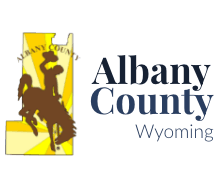Albany County updates wind regulations
Fight over wind energy development continues as ConnectGen plans 26,000-acre wind farm, commissioners commit to consider stricter regs, and both opposition, support grow more vocal
The Albany County Commissioners updated Albany’s wind regulations this week, adding to the boxes an energy company must tick off to be approved for development in the county.
The commissioners heard from a wide variety of voices. Many spoke to the importance of wind development in Albany County for combating climate change and boosting the local economy. Others said the new regulations did not go far enough in restricting what energy companies could do, suggesting larger buffer zones around turbines among other concerns.
While the regulations apply to all future proposed wind farms — one planned development is on everyone’s mind: the Rail Tie Wind Project.
The Rail Tie would be built on 26,000 acres of private and state land, and produce 504 megawatts of energy. ConnectGen estimates that Albany County will earn more than $3 million in tax revenue every year — and about $131 million over the life of the project, including $14.5 million in tax revenue from initial construction. That $14.5 million figure is equal to nearly 80% of all sales and use tax that went to the county in 2018, according to the Rail Tie Project website.
But opponents have been vocal, organized and well-funded, launching a sleek website and buying billboard space throughout the county. Those opponents have also made themselves heard at county commission and planning commission meetings for more than a year, advocating for stricter regulations.
Here are some highlights from the county commission meeting this week.
The new regulations add requirements for energy companies seeking to build wind farms in Albany County. Those companies must study their planned development’s impact on noise, wildlife and cultural resources, as well as its impact on the “socio-economic” status of the area. They must also up the amount of liability insurance from what was previously required. The regulations prohibit on-site waste disposal, and require construction oversight, as well as aircraft detection lighting — a system which only lights up when it senses aircraft in the area, rather than remain on at all times.
Several spoke in support of wind development and the Rail Tie project, especially young people. Laramie High School student Harlie Kaligis said the new regulations were fair, holding actors responsible while also allowing the community to develop renewable energy and do its part to protect the environment. “I feel an obligation and a desire to take action on environmental issues because these issues will affect everyone in the years to come,” Kaligis said. “Renewable energy is an important step in the fight to protect the planet that we all treasure.”
The issue has made allies of progressives and Republicans. Both see wind development as a way to diversify and boost the economy of Wyoming’s poorest county, while progressives add that investment in renewable energy is a moral necessity. At least two people affiliated with the group Better Wyoming voiced support during the commission meeting. “The tax revenues that come from this project would be a tremendous benefit for many people in our community,” said Better Wyoming Executive Director Nate Martin. “I look next door to Laramie County and I look next door to Carbon County, and they’ve all benefited significantly from the tax revenues coming from wind energy production.” Wind development also received vocal support from Republicans such as Roxie Hensley. Far from being a progressive, Hensley’s restaurant, Roxie’s on Grand, co-sponsored a right-wing militia-recruiting event in Albany County earlier this year as she herself ran as a Republican for Wyoming’s 45th House District.
The opposition, on the other hand, is led by local landowners — those who would likely be able to see wind turbines from their houses. “We support the regulations that are before you today, but we don’t feel they go near far enough,” said Paul Montoya, representing Albany County for Smart Energy Development. “We feel that the county needs to delve a little deeper.” Those opposed to the project, and in favor of stricter regulations, often cite concerns about the impact such development would have on landmarks such as the Ames Monument and Vedauwoo, as well as property values. “There are many appropriate places in the northern part of the county for wind energy industrialization,” Marian White said. “The consequences of poorly located wind farms are great and span economic prosperity, human health, animal wellbeing, and property values.” Responding to suggestions such as these, critics have accused the opposition of engaging in NIMBY-ism, saying “Not In My Backyard,” and pushing an undesirable situation into poorer neighborhoods less equipped to fight back.
The war over wind is far from finished. Commissioner Sue Ibarra echoed the concerns of several commenters, wondering if the regulations passed Tuesday go far enough and wondering if stricter regulations would be needed. The commissioners have tasked the county’s planning commission to look at issues such as buffer zones and fire suppression procedures. The planning commission has no power to set rules themselves, but advises the commissioners and could propose more energy siting regulations in the coming months.



